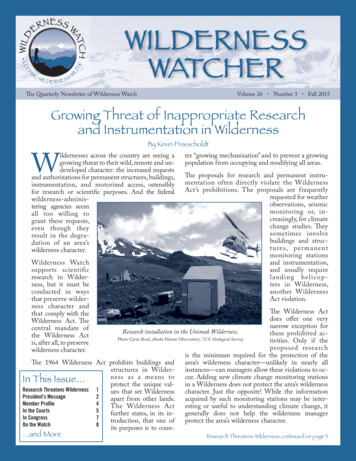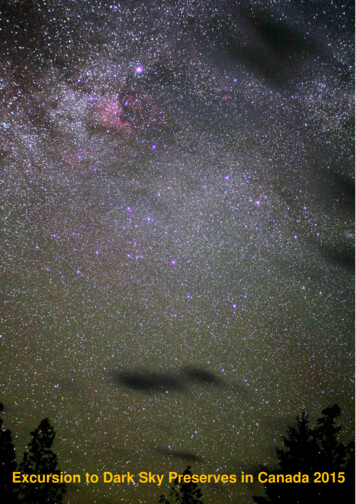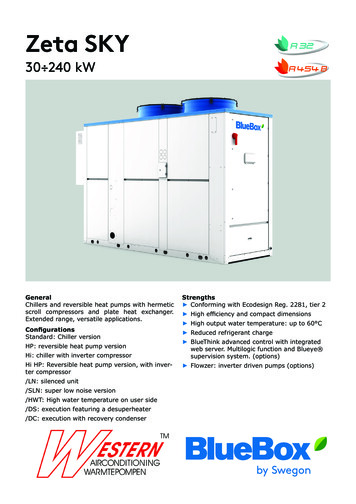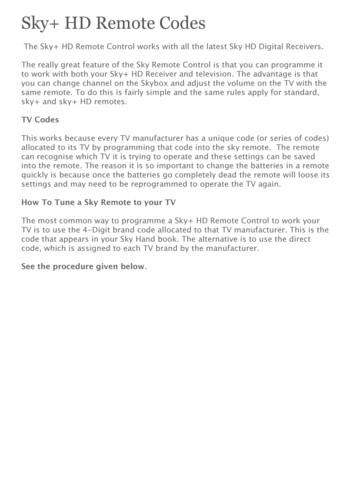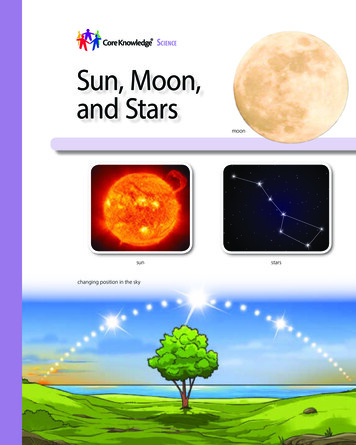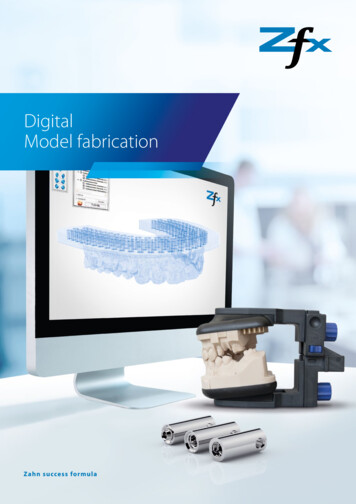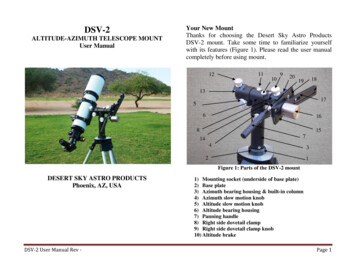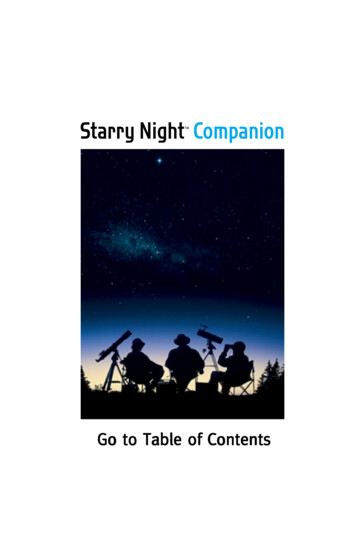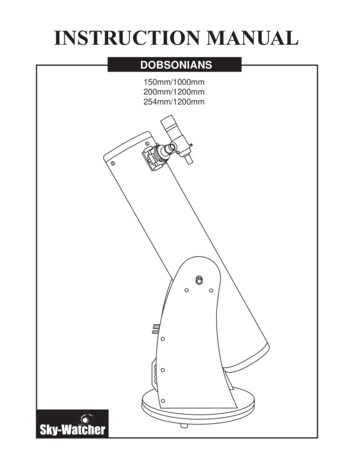
Transcription
DOBSONIANS150mm/1000mm200mm/1200mm254mm/1200mm
TABLE OF CONTENTSAssembling Your TelescopeParts ListBase AssemblyOptical Tube AssemblyOperating Your TelescopeAligning the FinderscopeFocusingUsing the optional Barlow LensUsing the Tension Control HandlePointing the DobsonianCalculating the Magnification (power)Calculating the Field of ViewCalculating the Exit PupilObserving the SkySky ConditionsSelecting an Observing SiteChoosing the Best Time to ObserveCooling the TelescopeAdopting Your Eyes3345666677888999999Proper Care for Your Telescope10CollimationCleaning Your Telescope1011Technical Support11Before you beginThis instruction manual is applicable to all the models listed on the cover. Read the entiremanual carefully before beginning. Your telescope should be assembled during daylighthours. Choose a large, open area to work to allow room for all parts to be unpacked.Caution!NEVER USE YOUR TELESCOPE TO LOOK DIRECTLY AT THE SUN. PERMANENTEYE DAMAGE WILL RESULT. USE A PROPER SOLAR FILTER FOR VIEWING THESUN. WHEN OBSERVING THE SUN, PLACE A DUST CAP OVER YOURFINDERSCOPE TO PROTECT IT FROM EXPOSURE. NEVER USE AN EYEPIECETYPE SOLAR FILTER AND NEVER USE YOUR TELESCOPE TO PROJECT SUNLIGHTONTO ANOTHER SURFACE, THE INTERNAL HEAT BUILD-UP WILL DAMAGE THETELESCOPE OPTICAL ELEMENTS.
PARTS LIST1. Base (Part 1)A1A2BPackage 2 (1 tube, 1 bolt,2 washers, 1 nut, 1 Teflon pad)Package 1 (14 screws,14 screw caps)Package 4(1 handle)DCPackage 5( 2 screws,1 Alan wrench)Package 3 (1 accessorytray, 3 screws)Package 6(4 cylindrical saddleside bearings,4 screws)Package 7(1 handle, 1 tensioncontrol handle)handletension control handle2. OTA (Optical Tube Assembly) (Part 2)Finderscope and bracketFinderscopemounting slotFocus locking screwRubber O Ring(Remove before installation)Two eyepieces(One 2" eyepiecefor models withPyrex glass)Dust cap/mask(remove before viewing)SecondaryFocusing Knobmirror positionSide bearingPrimary mirrorposition32" Eyepiecesadapter (notincluded in modelswith Pyrex glass)
BASE ASSEMBLY1. Connect the board B to theboard A1 and A2. Make surethe Sky-Watcher logos onthe board A1 and A2 are onthe outside. The side of theboard B with three small holesshould be facing the front.2. Connect the assemblyto the round board C.Sky-Watcherlogo on theother sideSky-Watcherlogo on theother side3. Place the teflon pad in betweenthe assembly from step 2 and theboard D. Insert the black tubefrom package 2 through the holesin the centre of all the above.A2A2A1A1This side onthe outsideCBD4. Take the bolt from pacage 2 with awasher on it and insert it through thetube. Secure with second washer andthe nut using the two wrench provided.Do not over-tighten the bolt. This willprevent the mount base from freelyspin on the bottom round board.5. Position the accessory trayover the 3 holes in the boardB and secure with the 3 smallscrews provided.6. Attach the handle from package4 to the board B with the twoscrews and the Alen wrenchfrom package 5.7. Unassemble the cylindricalsaddle side bearings and thescrews from package 5. Attachthe cylindrical saddle sidebearings to the inside of board Aand A1 using the screws provided.C8. Cover all visible small screws with the screw caps provided4
OPTICAL TUBE ASSEMBLY9. Place the optical tube between the boardA1 and A2. Make sure that the side bearingsof the tube are rested on the 4 cylindricalsaddle side bearings.10. Install the handles from package 7into the holes on the board A1 andA2. Do not over tighten the handles.Make sure that the tension controlhandle is installed on the same sideas the focuser for your convenience.12. Slide the finderscope bracket11. Locate the finderscope bracket13. Loosen the two adjustinginto the mounting slot and tightenand carefully remove the rubberscrews on the bracket. Positionthe screw to hold the bracket ino-ring from it. Position the o-ringthe finderscope into its backetplace.into groove on the finderscope tube.by sliding it backwards untilthe rubber o-ring seats. Alignas described below14. Remove the black plastic end-cap.Loosen the thumbscrews on theend of the focus tube if the end-capcan not be removed.15. Insert the desired eyepieceand lightly tighten the thumbscrews to hold the eyepiecein place.5
Aligning the FinderscopeFig.aThese fixed magnification scopes mounted on the optical tube arevery useful accessories. When they are correctly aligned with thetelescope, objects can be quickly located and brought to the centreof the field. Alignment is best done outdoors in day light when it'seasier to locate objects. If it is necessary to refocus yourfinderscope, sight on an object that is at least 500 yards (metres)away. Loosen the locking ring by unscrewing it back towards thebracket. The front lens holder can now be turned in and out tofocus. When focus is reached, lock it in position with the locking ring(Fig.a).Fig.b1. Choose a distant object that is at least 500 yards away and pointthe main telescope at it. Adjust the telescope so that the objectis in the centre of the view in your eyepiece.2. Check the finderscope to see if the object centred in the maintelescope view is centred on the crosshairs.3. Use the two small alignment screws to centre the finderscopecrosshairs on the object. The screws work in opposition to aspring-loaded knob (Fig.b).FocusingFig.cSlowly turn the focus knobs (Fig.c), one way or the other, until theimage in the eyepiece is sharp. The image usually has to be finelyrefocused over time, due to small variations caused bytemperature changes, flexures, etc. This often happens with shortfocal ratio telescopes, particularly when they haven't yet reachedoutside temperature. Refocusing is almost always necessarywhen you change an eyepiece or add or remove a Barlow lens.Using the Barlow lens (optional)A Barlow is a negative lens which increases the magnifying powerof an eyepiece, while reducing the field of view. It expands thecone of the focussed light before it reaches the focal point, so thatthe telescope's focal length appears longer to the eyepiece. TheBarlow should be inserted between the focuser and the eyepiecein your Dobsonian (Fig.d).In addition to increasing magnification, the benefits of using aBarlow lens include improved eye relief, and reduced sphericalaberration in the eyepiece. For this reason, a Barlow plus a lensoften outperform a single lens producing the same magnification.However, it is greatest value may be that a Barlow can potentiallydouble the number of eyepiece in your collection.6Fig.dEyepieceBarlow
Using the Tension Control HandleFig.etension controlLoosen or tightend the tension control handle to add just enoughfriction to allow the tube to move easily when nudged but to stayin position when not. It may be necessary to re-adjust the tensioncontrol handle when accessories are added to, or removed from,the tube. The tension control handle should be installed on thesame side as the eyepiece for your convenience. Leave thehandle on the other side slightly loose to allow full tension controlfor the tension control handle (Fig.e).Pointing the DobsonianPointing an altitude-azimuth (alt-az) mounted telescope, such as a Dobsonian, is relatively easy. With themount level, you can swivel the telescope around on a plane parallel to your horizon and then tilt it up anddown from there (Fig.f). You can think of it as turning your telescope in azimuth until it is facing the horizonbelow a celestial object and then tilting it up to the object's altitude. However, the Earth rotates and thereforethe stars are constantly moving, so to track with this mount you have to constantly nudge the optical tube inboth azimuth and altitude to keep the object in the field.In reference material for your local position, the altitude will be listed as degrees (minutes, seconds) aboveor below your horizon. Azimuth may be listed by the cardinal compass points such as N, SW, ENE, etc., butit is usually listed in 360 degree (minutes, seconds) steps clockwise from North (0 ), with East, South andWest being 90 , 180 and 270 , respectively (Fig.f).7
Calculating the Magnification (Power)The magnification produced by a telescope is determined by the focal length of the eyepiece that is usedwith it. To determine a magnification for your telescope, divide its focal length by the focal length of theeyepieces you are going to use. For example, a 10mm focal length eyepiece will give 80X magnification withan 800mm focal length telescope.Focal length of the telescopemagnification 800mm Focal length of the eyepiece10mm 80XWhen you are looking at astronomical objects, you are looking through a column of air that reaches to theedge of space and that column seldom stays still. Similarly, when viewing over land you are often lookingthrough heat waves radiating from the ground, house, buildings, etc. Your telescope may be able to givevery high magnification but what you end up magnifying is all the turbulence between the telescope and thesubject. A good rule of thumb is that the usable magnification of a telescope is about 2X per mm of apertureunder good conditions.Calculating the Field of ViewThe size of the view that you see through your telescope is called the true (or actual) field of view and it isdetermined by the design of the eyepiece. Every eyepiece has a value, called the apparent field of view,which is supplied by the manufacturer. Field of view is usually measured in degrees and/or arc-minutes(there are 60 arc-minutes in a degree). The true field of view produced by your telescope is calculated bydividing the eyepiece's apparent field of view by the magnification that you previously calculated for thecombination. Using the figures in the previous magnification example, if your 10mm eyepiece has anapparent field of view of 52 degrees, then the true field of view is 0.65 degrees or 39 arc-minutes.Apparent Field of ViewTrue Field of View Magnification 52 80X 0.65 To put this in perspective, the moon is about 0.5 or 30 arc-minutes in diameter, so this combination wouldbe fine for viewing the whole moon with a little room to spare. Remember, too much magnification and toosmall a field of view can make it very hard to find things. It is usually best to start at a lower magnificationwith its wider field and then increase the magnification when you have found what you are looking for. Firstfind the moon then look at the shadows in the craters!Calculating the Exit PupilThe Exit Pupil is the diameter (in mm) of the narrowest point of the cone of light leaving your telescope.Knowing this value for a telescope-eyepiece combination tells you whether your eye is receiving all of thelight that your primary lens or mirror is providing. The average person has a fully dilated pupil diameter ofabout 7mm. This value varies a bit from person to person, is less until your eyes become fully dark adaptedand decreases as you get older. To determine an exit pupil, you divide the diameter of the primary of yourtelescope (in mm) by the magnification.Diameter of Primary mirror in mmExit Pupil MagnificationFor example, a 200mm f/5 telescope with a 40mm eyepiece produces a magnification of 25x and an exitpupil of 8mm. This combination can probably be used by a young person but would not be of much value toa senior citizen. The same telescope used with a 32mm eyepiece gives a magnification of about 31x and anexit pupil of 6.4mm which should be fine for most dark adapted eyes. In contrast, a 200mm f/10 telescopewith the 40mm eyepiece gives a magnification of 50x and an exit pupil of 4mm, which is fine for everyone.8
Sky conditionsSky conditions are usually defined by two atmospheric characteristics, seeing, or the steadiness of the air,and transparency, light scattering due to the amount of water vapour and particulate material in the air.When you observe the Moon and the planets, and they appear as though water is running over them, youprobably have bad "seeing" because you are observing through turbulent air. In conditions of good "seeing",the stars appear steady, without twinkling, when you look at them with unassisted eyes (without atelescope). Ideal "transparency" is when the sky is inky black and the air is unpolluted.Selecting an observing siteTravel to the best site that is reasonably accessible. It should be away from city lights, and upwind from anysource of air pollution. Always choose as high an elevation as possible; this will get you above some of thelights and pollution and will ensure that you aren't in any ground fog. Sometimes low fog banks help to blocklight pollution if you get above them. Try to have a dark, unobstructed view of the horizon, especially thesouthern horizon if you are in the Northern Hemisphere and vice versa. However, remember that thedarkest sky is usually at the "Zenith", directly above your head. It is the shortest path through theatmosphere. Do not try to observe any object when the light path passes near any protrusion on the ground.Even extremely light winds can cause major air turbulence as they flow over the top of a building or wall. Ifyou try to observe on any structure, or even a sidewalk, movements you make may cause the telescope tovibrate. Pavement and concrete can also radiate stored heat which will affect observing.Observing through a window is not recommended because the window glass will distort imagesconsiderably. And an open window can be even worse, because warmer indoor air will escape out thewindow, causing turbulence which also affects images. Astronomy is an outdoor activity.Choosing the best time to observeThe best conditions will have still air, and obviously, a clear view of the sky. It is not necessary that the sky becloud-free. Often broken cloud conditions provide excellent seeing. Do not view immediately after sunset.After the sun goes down, the Earth is still cooling, causing air turbulence. As the night goes on, not only willseeing improve, but air pollution and ground lights will often diminish. Some of the best observing time is oftenin the early morning hours. Objects are best observed as they cross the meridian, which is an imaginary linethat runs through the Zenith, due North-South. This is the point at which objects reach their highest points inthe sky. Observing at this time reduces bad atmospheric effects. When observing near the horizon, you lookthrough lots of atmosphere, complete with turbulence, dust particles and increased light pollution.Cooling the telescopeTelescopes require at least 10 to 30 minutes to cool down to outside air temperature. This may take longer ifthere is a big difference between the temperature of the telescope and the outside air. This minimizes heatwave distortion inside telescope tube (tube currents). Allow a longer cooling time for larger optics. If you areusing an equatorial mount, use this time for polar alignment.Adapting your eyesDo not expose your eyes to anything except red light for 30 minutes prior to observing. This allows yourpupils to expand to their maximum diameter and build up the levels of optical pigments, which are rapidlylost if exposed to bright light. It is important to observe with both eyes open. This avoids fatigue at theeyepiece. If you find this too distracting, cover the non-used eye with your hand or an eye patch. Useaverted vision on faint objects: The center of your eye is the least sensitive to low light levels. When viewinga faint object, don't look directly at it. Instead, look slightly to the side, and the object will appear brighter.9
CollimationFig.gCollimation is the process of aligning the mirrors of yourtelescope so that they work in concert with each other todeliver properly focused light to your eyepiece. By observingout-of-focus star images, you can test whether yourtelescope's optics are aligned. Place a star in the centre ofthe field of view and move the focuser so that the image isslightly out of focus. If the seeing conditions are good, youwill see a central circle of light (the Airy disc) surrounded by anumber of diffraction rings. If the rings are symmetrical aboutthe Airy disc, the telescope's optics are correctly collimated(Fig.g).If you do not have a collimating tool, we suggest that youmake a "collimating cap" out of a plastic 35mm film canister(black with gray lid). Drill or punch a small pinhole in the exactcenter of the lid and cut off the bottom of the canister. Thisdevice will keep your eye centered of the focuser tube. Insertthe collimating cap into the focuser in place of a regulareyepiece.Corretly alignedNeeds collimationFig.hFocuserSupport forsecondary mirrorPrimary mirrorSecondary mirrorFig.iCollimation is a painless process and works like this:PrimarymirrorPull off the lens cap which covers the front of the telescopeand look down the optical tube. At the bottom you will see theprimary mirror held in place by three clips 120º apart, and atthe top the small oval secondary mirror held in a support andtilted 45º toward the focuser outside the tube wall (Fig.h).The secondary mirror is aligned by adjusting the central boltbehind it, (which moves the mirror up and down the tube),and the three smaller screws surrounding the bolt, (whichadjust the angle of the mirror). The primary mirror is adjustedby the three adjusting screws at the back of your scope. Thethree locking screws beside them serve to hold the mirror inplace after collimation. (Fig.i)Mirror cellLocking screwAdjusting screwFig.jPrimary mirror clipAligning the Secondary MirrorPoint the telescope at a lit wall and insert thecollimating cap into the focuser in place of a regulareyepiece. Look into the focuser through your collimatingcap. You may have to twist the focus knob a few turnsuntil the reflected image of the focuser is out of yourview. Note: keep your eye against the back of the focustube if collimating without a collimating cap. Ignore thereflected image of the collimating cap or your eye fornow, instead look for the three clips holding the primarymirror in place. If you can't see them (Fig.j), it meansthat you will have to adjust the three bolts on the top ofthe secondary mirror holder, with possibly an Allenwrench or Phillip's screwdriver. You will have toalternately loosen one and then compensate for theslack by tightening the other two. Stop when you see allthree mirror clips (Fig.k). Make sure that all three smallalignment screws are tightened to secure thesecondary mirror in place.Fig.kPrimary mirror clipIgnore the reflectedimage for nowPrimary mirror clipPrimary mirror clip10
Aligning the Primary Mirrorhex bolt insideFig.lThere are 3 hex bolts and 3 Phillip's head screwsat the back of your telescope, the hex bolts are thelocking screws and the Phillip's-head screws arethe adjusting screws (Fig.l). Use an Allen wrenchto loosen the hex bolts by a few turns. Now runyour hand around the front of your telescopekeeping your eye to the focuser, you will see thereflected image of your hand. The idea here beingto see which way the primary mirror is defected,you do this by stopping at the point where thereflected image of the secondary mirror is closestto the primary mirrors' edge (Fig.m).When you get to that point, stop and keep yourhand there while looking at the back end of yourtelescope, is there a adjusting screw there? If thereis you will want to loosen it (turn the screw to theleft) to bring the mirror away from that point. Ifthere isn't a adjusting screw there, then go acrossto the other side and tighten the adjusting screw onthe other side. This will gradually bring the mirrorinto line until it looks like Fig.n. (It helps to have afriend to help for primary mirror collimation. Haveyour partner adjust the adjusting screws accordingto your directions while you look in the focuser.)Fig.mSecondarymirrorstop and keep yourhand herePrimary mirrorFig.nAfter dark go out and point your telescope atPolaris, the North Star. With an eyepiece in thefocuser, take the image out of focus. You will seethe same image only now, it will be illuminated bystarlight. If necessary, repeat the collimatingprocess only keep the star centered while tweakingthe mirror.Both mirrors alignedwith collimating cap inBoth mirrors aligned witheye looking in focuserCleaning your telescopeReplace the dust cap over end of telescope whenever not in use. This prevents dust from settling on mirroror lens surface. Do not clean mirror or lens unless you are familiar with optical surfaces. Clean finderscopeand eyepieces with special lens paper only. Eyepieces should be handled with care, avoid touching opticalsurfaces.11
TECHNICAL SUPPORTCanada:Tel: 604-270-2813 between 9:00AM and 4:00PM PST, Fax: 604-270-2330E-mail: support@skywatchertelescope.comOutside Canada: Please contact your dealer for technical support.www.SkywatcherTelescope.comNEVER USE YOUR TELESCOPE TO LOOK DIRECTLY AT THE SUN. PERMANENT EYEDAMAGE WILL RESULT. USE A PROPER SOLAR FILTER FOR VIEWING THE SUN. WHENOBSERVING THE SUN, PLACE A DUST CAP OVER YOUR FINDERSCOPE TO PROTECT ITFROM EXPOSURE. NEVER USE AN EYEPIECE-TYPE SOLAR FILTER AND NEVER USEYOUR TELESCOPE TO PROJECT SUNLIGHT ONTO ANOTHER SURFACE, THE INTERNALHEAT BUILD-UP WILL DAMAGE THE TELESCOPE OPTICAL ELEMENTS.
Make sure the Sky-Watcher logos on the board A1 and A2 are on the outside. The side of the board B with three small holes should be facing the front. 5. Position the accessory tray . Pointing an altitude-azimuth (alt-az) mounted telescope, such as a Dobsonian, is relatively easy. With the mount level, you can swivel the telescope around on a .
